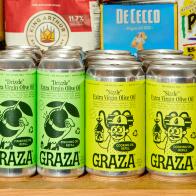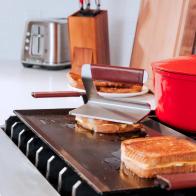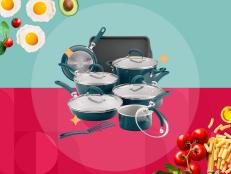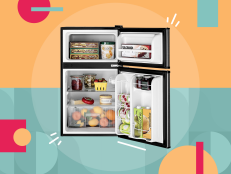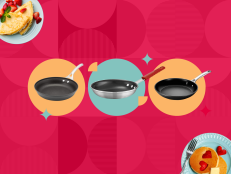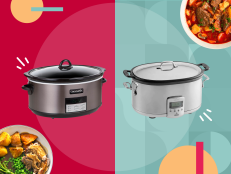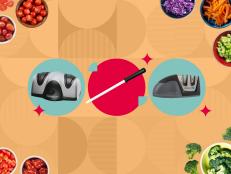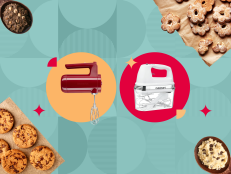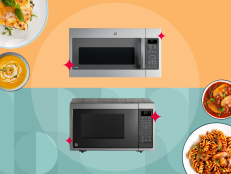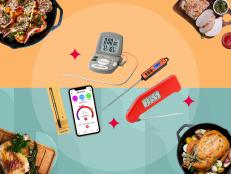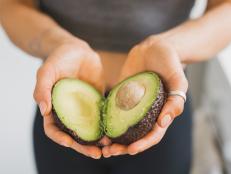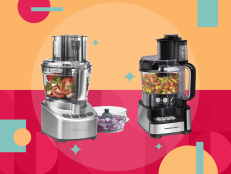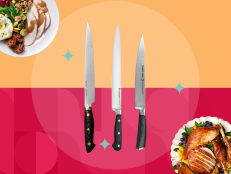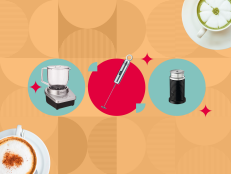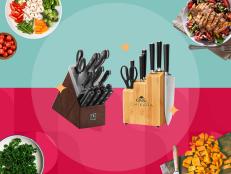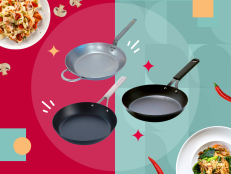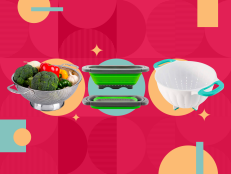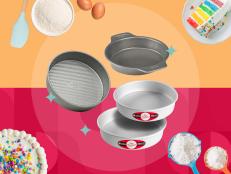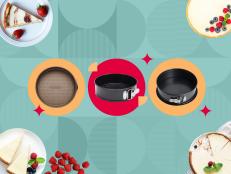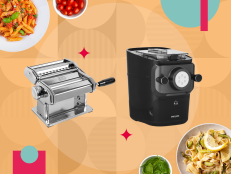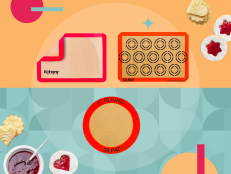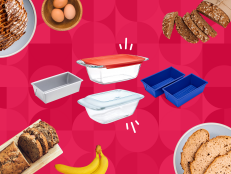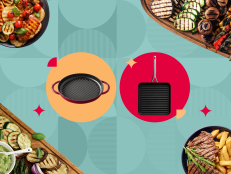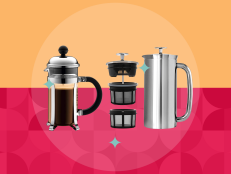5 Best Cupcake and Muffin Pans of 2024, Tested and Reviewed
We found the best standard, jumbo and mini muffin pans on the market for making muffins, cupcakes, egg cups and more.

Our Top Cupcake and Muffin Pan Picks
- Best Overall: Food Network 12-Cup Textured Bakeware Muffin Tin
- Best Non-Stick Pan: Wilton Perfect Results Premium Non-Stick Cupcake Pan
- Best Silicone: Silpat Non-Stick Silicone Muffin Pan
- Best Mini Muffin Pan: USA Pan Mini Muffin Pan
- Best Jumbo Muffin Pan: Wilton Recipe Right Non-Stick Jumbo Muffin Pan
Tested by Layla Khoury-Hanold for Food Network Kitchen
Cupcake and muffin pans are a must-have baking tool — their versatility beyond their namesake sweet staples earns them a spot in any home kitchen. We love that muffin pans can be used for savory recipes like Mini Lasagna Cups or Hash Brown Mac and Cheese Cups, or to reinvent desserts, like Mini Taco S’mores. On the surface, cupcake and muffin pans are straightforward, but there are a few things to consider to find the best pan for your needs and budget. For example, if you make egg cups often and need a guaranteed easy-release, you might want to opt for a non-stick finish. If you bake often, it might be worth investing in a professional-grade silicone model that yields even cooking results and uniform browning.
Let us address something right off the bat. We know it might seem convenient that a Food Network-branded product was our top pick, but rest assured that we employed the same rigorous evaluation that all of our product tests undergo. We tried out 10 cupcake and muffin pans in a variety of sizes and materials, ranging in price from $10 to $60, assessing their baking performance, design, ease of care, and any special features (like non-stick finish or no-greasing required). Ultimately the Food Network Textured Bakeware Muffin Pan hit the trifecta: superior non-stick baking performance, durable design and construction, and an affordable price tag.
Here are a few more things to keep in mind when you’re shopping for and using cupcake and muffin pans.

Layla Khoury-Hanold
What to Know About Buying and Using Cupcake and Muffin Pans
Size: Muffin and cupcake pans come in standard, mini or jumbo sizes. Consider what you’ll be baking most often, as well as the quantity and intended purpose of those baked goods (i.e. bake sales, meal prep, or straight up snacking). Also take note of how many pans are included with the model (some jumbo sets come with two pans).
Material: Non-stick metal pans are made from aluminum, stainless steel, carbon steel or silicone, all of which can influence how efficiently the pan conducts heat. This impacts how long your recipe will take to bake, as well as how much browning you can expect. Aluminum is commonly used as it’s a good heat conductor and distributes heat evenly, which ensures consistent baking results. Non-stick pans are typically made from stainless steel. Although they conduct heat more slowly (meaning your muffins will bake more slowly), your baked goods benefit from more lift and doming. The trade-off is that most non-stick pans are hand-wash only to help extend product life and performance. Carbon steel pans offer solid heat conduction and a non-stick finish, making them a baking workhorse. Silicone pans blend excellent heat-conduction and non-stick properties, but they are flimsier in construction, and some require that you bake with a sheet pan underneath.
Greasing: Never use a non-stick spray on a non-stick pan as it can ruin the finish. You can use aerosol canola oil or olive oil spray, but avoid the ones labelled “non-stick sprays” because they don’t come off. When in doubt, greasing a pan with butter is a tried-and-true method.
Design: To ensure that your product is durable and won’t warp, look for models that tout reinforced or fluted edges or textured finishes. Keep an eye out for design features such as extra room around the lip (the side areas) to accommodate oven mitts and facilitate ease of handling.
Special Features: Look for manufacturer claims such as non-stick finish, easy release, easy to wash, and no greasing required to assess how product design and what you can reasonably expect performance-wise. Keep an eye out for solid product warranties which can justify investing in pricier or professional-grade models, such as a limited lifetime warranty, 10 year warranty, or hassle-free replacements.
Liners: Liners aren’t always necessary, particularly if you have a solid non-stick pan and properly grease it. Paper liners can add festive flair, which is a nice touch if you’re gifting baked goods. While they’re not reusable, paper or foil liners can help save on clean-up for messier recipes that are more likely to stick, such as these Mac ‘n’ Cheese Bites. Reusable silicone cups can be used in your nonstick pans if you feel like skipping the greasing step (plus, arranging these silicone rainbow liners in the muffin pan are a fun baking task for kids).
Care: Handwashing your pan before first use and after each use is recommended. Even if your pan is dishwasher safe, don’t use it in your machine with dishwashing tablets as they contain concentrated cleansers that will damage your pan’s finish and alter its performance. Avoid using abrasive cleaning products or sponges to protect the pan’s finish.
Before first use: Once you receive your product, be sure to inspect it for any damage to ensure that all labels, manuals and pieces are included (some models come with two pans) and that the pan edges haven’t been dented during shipment. Read the care instructions to determine how to wash and dry your cupcake and muffin pan before first use.

Layla Khoury-Hanold
How We Tested
We purchased 10 top-rated cupcake and muffin pans according to various online sites, reviews and bestseller rankings. We tested standard, mini and jumbo-size cupcake and muffin pans across a range of price points in a variety of materials including aluminum, stainless steel, carbon steel and silicone.
Part 1: Product Intake & Pre-Use
First, we noted the product name, price, size, number of cups, and number of pans included. Then we recorded the material (such as carbon steel, aluminum, stainless steel or silicone) and whether it was non-stick. Next, we looked for a manual or label with instructions on how to use the pan and how to care for it and recorded important contents. Of particular significance was noting whether the user needed to do anything to the pan prior to first use, as well as how the pan should be cleaned and cared for after each use.
We also noted any special claims and observed design features like fluted edges for reinforced strength, textured bottoms for added durability, or wide handles to accommodate oven mitts. Finally, we documented the details of any included product warranties.

Layla Khoury-Hanold
Part 2: Baking
We conducted the food test in two parts, first baking the muffins using a standard, boxed muffin mix, and then performing a taste test.
For testing baking performance, we used a standard store-bought muffin mix and followed instructions to lightly grease the pan (we used butter for all pans tested). We followed the suggested baking temperature and time range, which stated that standard muffins be baked at 400 degrees F for 18 to 22 minutes and that mini muffins be baked at 400 degrees for 14 to 16 minutes. For the jumbo muffin pans, we pre-determined 400 degrees for the oven temperature and a baking time range of 20 to 25 minutes. We decided that the muffins were done baking based on the suggested timings and confirming doneness by inserting a toothpick in the center to ensure it came out clean.
Next, we followed the muffin mix package’s directions to let the muffins cool in the tin for 5 minutes before transferring them to a cooling rack. Once we removed the muffins from the pan, we assessed how evenly the muffins baked and if they were cooked all the way through. We noted how much doming they had and if the doming was even. We checked the sides and bottoms of the muffins for even coloring and browning after baking.

Layla Khoury-Hanold
Finally, we conducted a taste test by cutting a muffin in half and observing whether it was dense or light and fluffy, and observing its texture, using qualitative evaluators such as dry, moist, just right, or cakey. We also noted any textural contrast achieved, such as a buttery, crisp muffin top edge.
Part 3: Cleaning
Here we noted whether any of the pans were dishwasher safe and best practices for cleaning and care. Next, we evaluated how easy or difficult it was to hand wash the pan after baking, observing if any baked muffin batter stuck to the pan. We also noted whether the pan included any instructions on using the soft/rough side of the sponge to clean. Even if pans were dishwasher safe, many manufacturers recommend hand washing the pan with warm, soapy water and to avoid any abrasive sponges or tools. Models that were dishwasher safe also came with a notice to avoid using dishwasher detergent tablets because they contain concentrated cleansers that damage the pan’s finish. Many labels also tell users to avoid cleaning your pans with abrasive cleaners or scouring pads; when in doubt, look for products labelled “safe for non-stick surfaces.”
Best Cupcake and Muffin Pans
This carbon steel muffin pan earned top marks for its non-stick performance, durable construction, thoughtful design, and modest price tag. Since this pan was developed as part of Food Network’s Performance Series bakeware, it had to live up to its name. This meant thorough development of a non-stick, silicone-based coating that easily released baked goods. The coating is eco-friendly and free of PTFE, PFOA and PFAS.
The pan’s label claimed that the pan’s textured bottom improved air flow for even baking, which we found to be true given even baking results and consistent browning on the muffins’ sides and bottoms. The pan’s textured finish also gives it added heft in the hand, suggesting durability. Another important feature is the pan’s shape, which allows plenty of room for the lips — the side areas around the cups — so, you can easily grip the pan with oven mitts when transferring it to and from the oven without worrying about sticking your mitts in the cupcake batter or smooshing the muffins. The pan is hand-wash only, but the non-stick finish helped ensure easy clean-up. The pan is oven safe to 450 degrees F, making it ideal for those times when you want to start baking at a higher temperature to create extra lift in your baked goods. This pan also comes with a limited lifetime guarantee.
This steel pan delivered on its non-stick results claim, making this a great option if you frequently bake muffins and cupcakes or regularly make egg cups. During the baking portion of the test, we found that the pan yielded muffins that were evenly cooked, with good doming and an even, golden-brown coloring. The muffins came out light and fluffy, with a just-right texture that veered slightly on the cakey side. The pan is dishwasher safe, but handwashing is recommended. There was no stuck-on batter, making clean-up a cinch.
We really loved this pan’s solid baking performance, and it’s easy to see why it’s a favorite among professional chefs and bakers. It performed to the high levels that we’d expect of a best overall pan, but the $60 price point is an investment, and it might not be right for everyone. One major plus is that this pan’s food-grade silicone coating gives it a premium non-stick finish and it doesn’t require greasing (in fact, the directions explicitly state not to grease the pan).
Although it’s made with a lightweight, flexible material, it’s not as sturdy as some of the other pans and requires users to bake in conjunction with a sheet tray, adding another piece of equipment (and more dishes). Still, it’s a minor drawback given its high-performance capabilities. We found that it produced uniformly baked goods, with even doming and consistent browning on the muffins’ tops, sides and bottoms. The muffins were light and fluffy and boasted a just-right, moist texture with a slight crisp on the muffin tops’ edges. The pan is dishwasher safe, but easily wipes and rinses clean with a damp, soft sponge. This pan came in a dedicated box with clear use and care instructions, indicating a durable, well-made product. In addition, this pan is oven safe to 500 degrees F, as well as freezer safe, which is especially handy if you like to employ your freezer for meal prep, or to freeze individual portions of leftover broth, soup or sauce.
This non-stick mini muffin pan just edged out the competition, yielding muffins with a slightly better texture. Overall, the muffins released easily from the pan as promised, were evenly cooked through, light and fluffy, with a just-right texture that had a slight crisp along the muffin tops’ edges. We also appreciated its durable design and features such as fluted surface for added strength, oven safe capability up to 450 degrees F, and a limited lifetime warranty. The pan isn’t dishwasher safe, but thanks to the non-stick silicone coating, no batter stuck and it washed up easily.
We also tested the Wilton Perfect Results Mini Muffin Pan which performed well, so if you’re looking for a budget mini muffin pan or just plan to use the pan a handful of times, this pan will do just fine. It’s worth noting that both pans baked the mini muffins evenly, but we observed uneven coloring on the muffins’ sides and bottoms in both models.
This jumbo pan came with two pans, each boasting six jumbo-size cups. It lived up to its non-stick promise with easy-release muffins. The muffins were evenly baked, cooked all the way through, with good doming. The sides browned evenly, although there was a slight inconsistency in the browning on the muffins’ bottoms. The muffins were light and fluffy with a slight, buttery-crisp texture on the muffin top edges. We appreciated the large handles which provided a secure grip, even while wearing oven mitts, ensuring safe and easy handling. The pan is dishwasher safe, although handwashing in warm, soapy water is recommended. The pan comes with a limited 5-year warranty.












